10 Effective Ways To Protect Plants From Frost
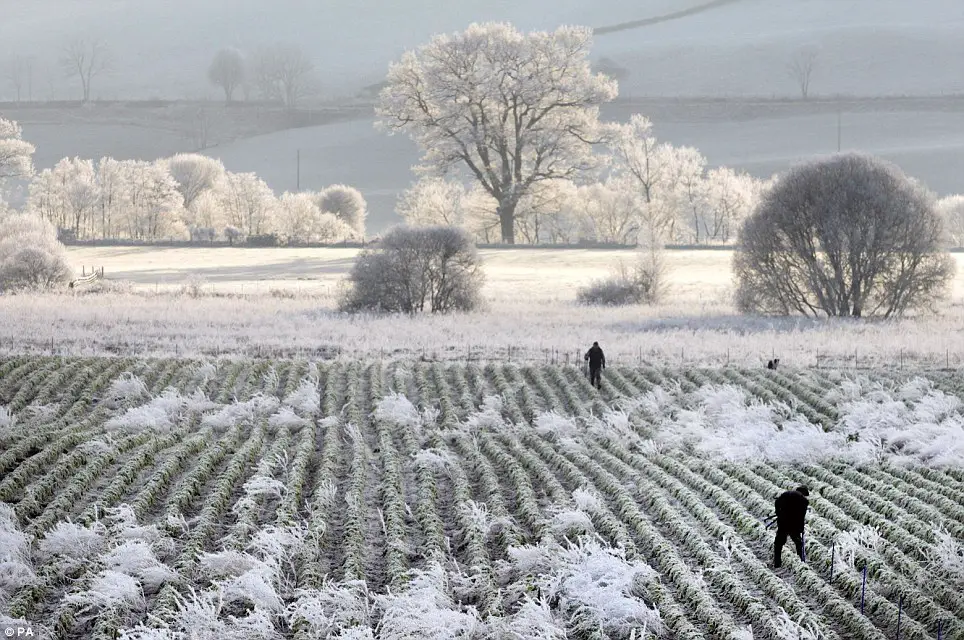
One of the biggest worries for gardeners in the spring is the threat of fluctuating temperatures that lead to frost that can harm or even kill plants. Here’s what you need to know to protect tender plants from frost and seasonal freezing nighttime temperatures.
There are a number of ways to protect your plants from frost. A heated greenhouse is the best option but you can cover exposed plants with adapted normal household containers or a garden fleece or by “wrapping” very vulnerable plants.
You can also protect roots using varied materials such as mulch.
It is important to note that freezing can occur even when no frost is present and protecting your plants against this is just as important.
Let’s look in more detail at what steps you can take to best frost-proof your plants. Before frost comes it is a good idea to be prepared in advance.
Table of Contents
- How To Win The Battle Against Frost
- 3 Easy Preventative Measures You Can Take Before The Frost Sets In
- 10 Highly Effective Ways To Protect Plants From Frost
- 1. How to protect plants from frost in a greenhouse
- 2. Insulation is a great addition for frost protection
- 3. Invest in a heating system to protect plants from frost
- 4. Heat mats are a cheaper alternative for plant frost protection
- 5. Use a garden fleece for simple plant frost protection
- 6. Mulch is great for protecting plant roots from frost
- 7. Wrapping is great for protecting fruit plants from frost
- 8. Fleece covers are a great cheap way of protecting plants from frost
- 9. Adapted pots & plastic bottle covers work really well as frost protection
- 10. How to use water to protect your plants against frost
How To Win The Battle Against Frost
Although there are many things to consider when gardening in the spring one of the biggest concerns for gardeners is frost. Plummeting nighttime temperatures that freeze the warm spring moisture in the air can cause havoc with plants and harm vulnerable seedlings or even kill them.
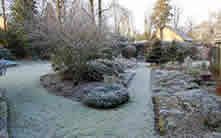 Frost occurs when ice is formed from humid air that meets dropping temperatures. Although it can occur at anytime it most frequently occurs at night.
Frost occurs when ice is formed from humid air that meets dropping temperatures. Although it can occur at anytime it most frequently occurs at night.
Frost forms on objects, such as plants, when their temperature drops below the freezing point of water which is about 0 °C or 32 °F.
As the plant loses its heat with lowering temperatures frost can develop on and around the plant.
Different plants react differently to frost. There are more cold-hardy plants that barely react at all why there are more tender varieties that will suffer or even die if they are allowed to come into contact with frost.
3 Types of frost that damage exposed plants
Frost occurs on clear windless nights when the air temperature approaches freezing point. At this time the surface temperature of your plants can dip below freezing causing ice crystals to form on them.
This happens in a similar way to the formation of dew during warmer nights.
There are three types of frost that harm plants which you should be aware of:
- Hoarfrost
- Rime
- Black frost
Hoarfrost
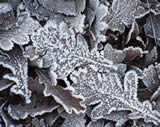 Hoarfrost is the most familiar type of frost to many of us.
Hoarfrost is the most familiar type of frost to many of us.
It a grey-white crystalline deposit of frozen water that forms on vegetation.
It results when water in the air is deposited directly in the form of ice crystals.
Hard Rime & Soft Rime
Rime occurs when water is deposited in a liquid form from fog ( or sometimes dew) and then freezes.
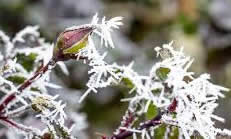 Hard rime is white in color and is ice that forms when the water droplets in fog freeze to the outer surfaces of objects. Hard rime is dense and will cause the most damage to plants.
Hard rime is white in color and is ice that forms when the water droplets in fog freeze to the outer surfaces of objects. Hard rime is dense and will cause the most damage to plants.
Soft rime occurs when fog freezes to the windward side of tree branches and plants. Soft rime is less dense than hard rime.
Rime has a white glazed appearance and is very crystalline looking.
Black Frost
Black frost is a bit of a misleading term.
Black frost refers to those times when no frost is actually formed but plants are still damaged by freezing temperatures.
Many times foliage will turn black when it comes in contact with black frost conditions.
How some plants react to frost & why you need to protect them
Some plants react better to frost than others.
There are plants that simply cannot handle frost even in small amounts.
Tropical and frost-tender plants can’t survive freezing temperatures as they have evolved to grow in warm climates where frost does not occur.
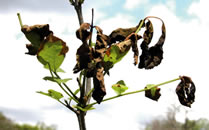 Tropical plants must be protected against frost or they will likely die.
Tropical plants must be protected against frost or they will likely die.
Annual plants won’t survive a freeze either but fortunately all is not lost with these plant types as they do disperse seeds that will lie dormant until the weather gets warmer when they will germinate and start the cycle of growth and death again.
Root-hardy perennials will appear to die in freezing temperatures as the foliage decays.
However, the roots can survive these temperatures and go into a dormant state until the warmer weather arrives wen they will begin the growth cycle again.
Fully hardy perennials, tress and shrubs fair much better against frost and freezing. These plants enter a dormant state and reduce the sap they produce while also conserving water.
Early blooms and foliage from these plants can be damaged by frost but the plant’s recovery is usually pretty quick.
The best time to protect plants against frost
Plants need protecting when the temperature is set to drop below freezing.
Frost is usually a problem for gardeners in the early spring when warm days are met with cold nights.
 As I already mentioned it is important to note that freezing can occur even when no frost is present and protecting your plants against this is just as important as frost-proofing them is.
As I already mentioned it is important to note that freezing can occur even when no frost is present and protecting your plants against this is just as important as frost-proofing them is.
Early spring is a strange time for temperatures when the daylight hours can see pleasant warm spells while the night can be ultra chilly with plummeting temperatures.
This is the season when most frost occurs.
3 Easy Preventative Measures You Can Take Before The Frost Sets In
There are steps you can take to help prevent the potential damage caused by frost even before you have been alerted to possible temperature drops.
The first step is very obvious – use cold-friendly plants in your garden.
1. Cultivate cold-friendly and frost-resistant plants
There are certain plants that react better to frost and freezing temperatures than others.
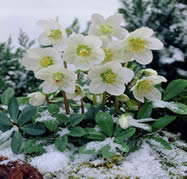 Planting cold-weather plants that can survive colder weather is probably the easiest way to avoid frost problems in your garden and it is definitely something you should consider if you live in a colder zone.
Planting cold-weather plants that can survive colder weather is probably the easiest way to avoid frost problems in your garden and it is definitely something you should consider if you live in a colder zone.
If you stick to native plant varieties then frost is not likely to be a problem as those varieties will have evolved to deal with such conditions.
However, gardens would be boring if we all planted them the safe the way! This approach also doesn’t help when you have a vegetable garden.
Here a few preventative measures to take before the frost hits.
2. Move outdoor potted plants to frost-resistant places
There are areas in your garden that will be more prone to frost than others due to wind.
Natural, or fabricated, protection can go a long way to protecting plants against frost.
By planting your garden with foresight you can avoid the hindsight that comes from expensive lessons. You can also move any potted garden plants to these areas during the winter or whenever frost is predicted.
Place your plants in areas that are less likely to experience frost.
You may also want to erect some kind of temporary windbreaker to help lessen the likelihood of cold winds affecting the area.
If you have pot plants the simplest solution is to bring them indoors overnight.
Of course it isn’t always possible to bring in outdoor potted plants. So, just move them to a more secluded area that is protected from the elements more than their current location is.
3. Use the hardening off technique to acclimatize your plants to frost before you plant them
When you are planting from seedlings you can do something known as hardening off.
Before you plant seedlings you can acclimatize them to outdoor temperatures by gradually exposing them to conditions outside.
 Gradually introduce your new seedlings to the outdoors in stages over a period of one or two weeks.
Gradually introduce your new seedlings to the outdoors in stages over a period of one or two weeks.
To do this simply set them outside for a few hours each day for the first few days and then gradually lengthen that time until they are ready to spend a whole day outside.
After two weeks, the seedlings will be much stronger and sturdier plants and will be ready for transplanting in their permanent residence outdoors.
The process of hardening off will help your plants grow stronger and make them more resilient to changing weather conditions.
10 Highly Effective Ways To Protect Plants From Frost
There is no one “best way to protect plants from frost”. There are multiple ways, and a hybrid approach is usually the best one to adopt to ensure you give your plants the greatest amount of protection possible.
1. How to protect plants from frost in a greenhouse
Plants that live in a greenhouse are automatically much more protected from frost and freezing temperatures than than those that live in the open air.
However, greenhouse plants still need some TLC during cold spells as frost can just as easily occur inside a greenhouse when condensation freezes.
Preparing your greenhouse for spring frost does not take much time or effort and may not at all be necessary if you have already spent time getting it ready for the winter.
Here are some simple steps you can take to help frost-proof greenhouse plants.
2. Insulation is a great addition for frost protection
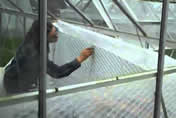 Insulating your greenhouse against falling temperatures is another great way to avoid the damage caused by frost and freezing.
Insulating your greenhouse against falling temperatures is another great way to avoid the damage caused by frost and freezing.
You should have already prepared your greenhouse for winter with some type of insulation so it is just a matter of keeping it up until late spring or very early summer.
You can use commercial grade reflective foil insulation or bubble wrap
(with larger bubbles so the material lets in more light) so try to avoid the small bubble type.
You can read more about insulating your greenhouse here.
3. Invest in a heating system to protect plants from frost
A thermostat controlled heating system will eliminate any risk of frost or freezing temperatures damaging your plants.
Really, if you use your greenhouse extensively then even a budget-friendly heating system is preferable over using none.
If your budget can stretch or you have a large greenhouse with plants that are very important to you then you should invest in a good heating system that you can use in the winter moths as well.
4. Heat mats are a cheaper alternative for plant frost protection
Using heat mats is one of the cheapest ways to help protect your greenhouse plants from the effects of freezing and frost.
Although a heat at is not an ideal solution, as the foliage and upper pars of the plant are still likely to drop in temperature, using them is better than using nothing. And, the heat mat will also protect the roots.
5. Use a garden fleece for simple plant frost protection
A horticultural garden fleece is a very inexpensive way to protect your plants in greenhouse at night.
6. Mulch is great for protecting plant roots from frost
Using mulch around your plants can help protect the roots from freezing temperatures while also providing much-needed nutrients.
Even grass from a mulching mower is sufficient for this purpose.
7. Wrapping is great for protecting fruit plants from frost
Wrapping plants is a great way to protect them from falling temperatures. This is especially true if you have fruit trees.
You should wrap the trunks of trees with burlap strips or tree wrap as most fruit trees have thin barks that are very susceptible to splitting (know as frost crack). Frost crack occurs when there is dramatic fluctuating temperatures.
8. Fleece covers are a great cheap way of protecting plants from frost
A horticultural garden fleece is the most common covering to use on outdoor plants at night.
Many people wonder what the temperature should be to cover plants.
As a rule of thumb you should cover plants when you know freezing temperatures or a frost is coming.
A fleece will protect the plant from freezing temperatures and frost as well as blanketing in the plant’s own heat.
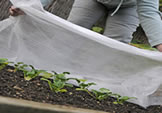 If you don’t want to invest in a garden fleece or have a lot of area to cover then you can use old clothes, just be aware that they will not give the same level of protection.
If you don’t want to invest in a garden fleece or have a lot of area to cover then you can use old clothes, just be aware that they will not give the same level of protection.
Whichever covering you use you will get the best results if you drape it over some type of frame to keep it from touching any plant foliage.
Fabric covers help to trap heat from the soil, so make sure your cover drapes right down to the ground.
Just be sure you remove the fleece in the morning as it will block sunlight from reaching the plant!
9. Adapted pots & plastic bottle covers work really well as frost protection
Covering tender seedlings and vulnerable plants with containers is another very inexpensive way to protect them from frost.
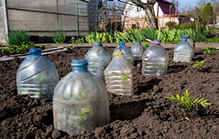 Something as simple as an inverted plant pot will often offer more than enough protection against frost.
Something as simple as an inverted plant pot will often offer more than enough protection against frost.
Although I prefer to avoid plastic in the garden as much as possible I have been known to use large cut-open plastic bottles for frost protection and they work incredibly well.
These have the added advantage of letting in light if you need to keep your protection on for longer periods during very cold spells.
Ensure that the bottle caps are removed to allow the plant access to air.
You can really use anything that will cover the plant fully without touching it and that will not inhibit airflow so don’t be afraid to get creative.
10. How to use water to protect your plants against frost
This feels like a very counter-intuitive thing to do but …
… actually watering around your plants the night before a spring frost is predicted can go a long way to protecting them from freezing.
Why is this? Surely the water would freeze and cause even more ice. Well….no that’s no what happens.
At night the soil will release the extra moisture into the air and this vapor will actually help to raise the local surrounding temperature thus keeping the plants warmer.
Strange but true.
Thanks for reading! I'm Michael — houseplant fanatic and your Pinterest plant guide.
Follow me on Pinterest for fresh updates 🌿



